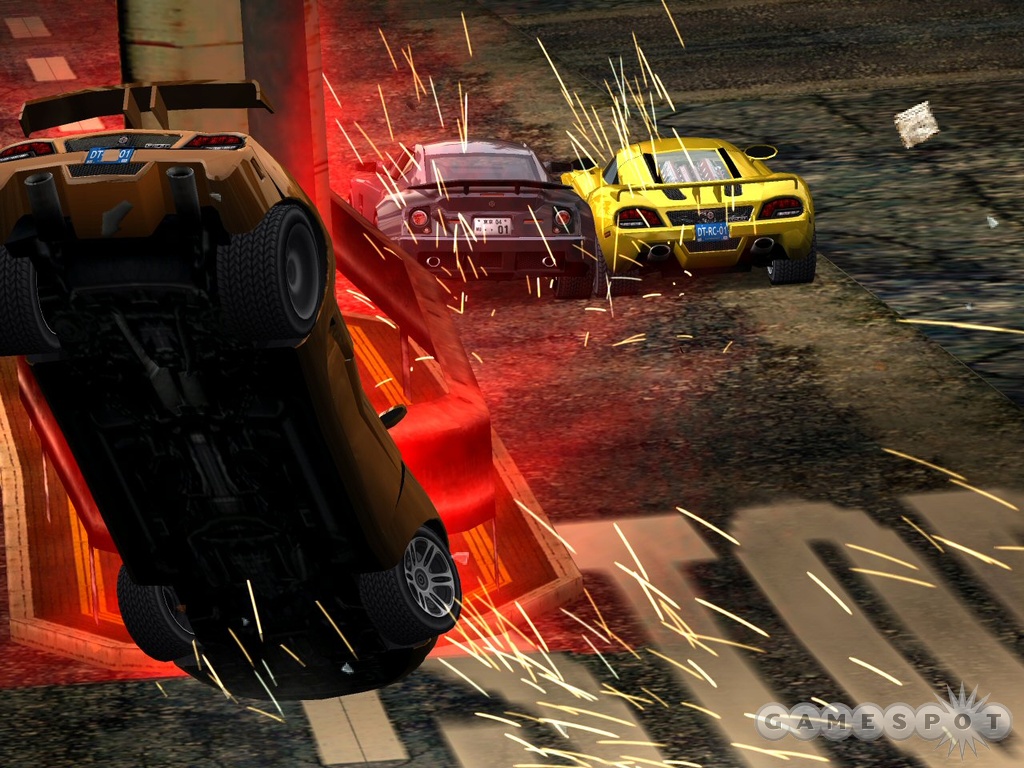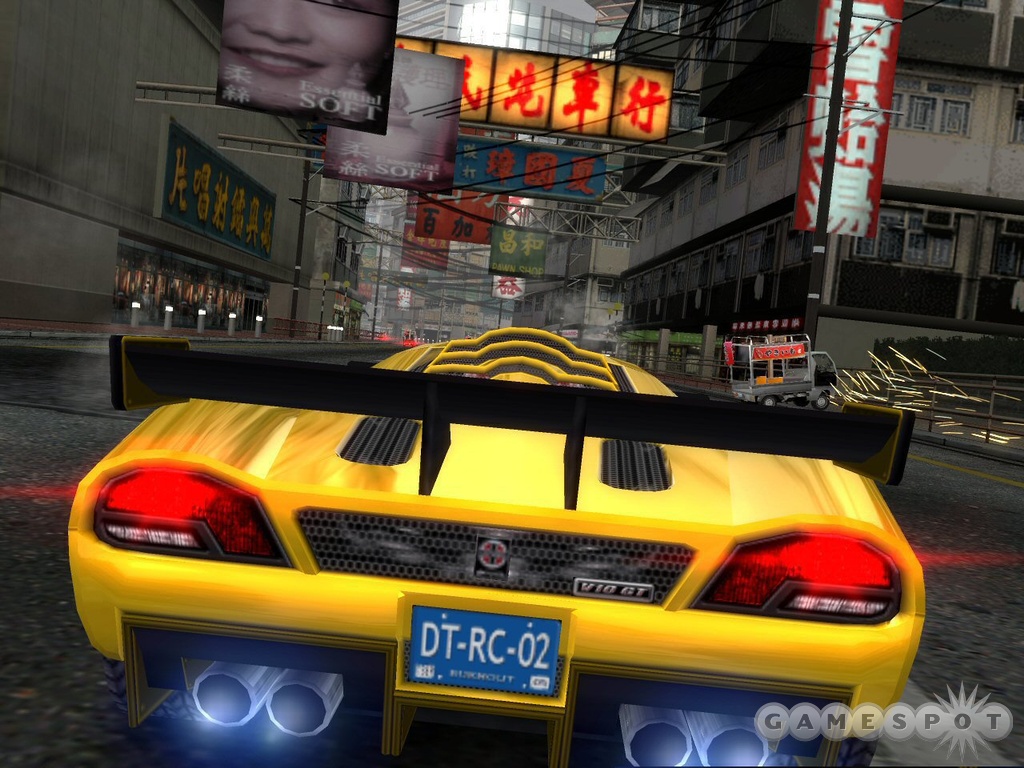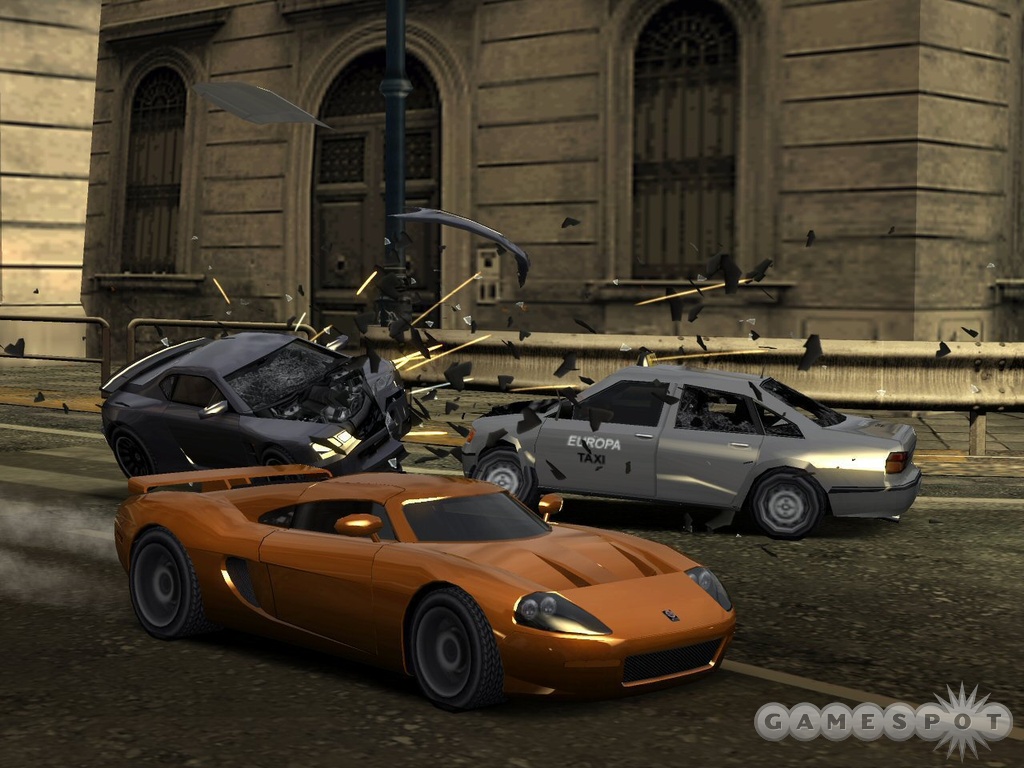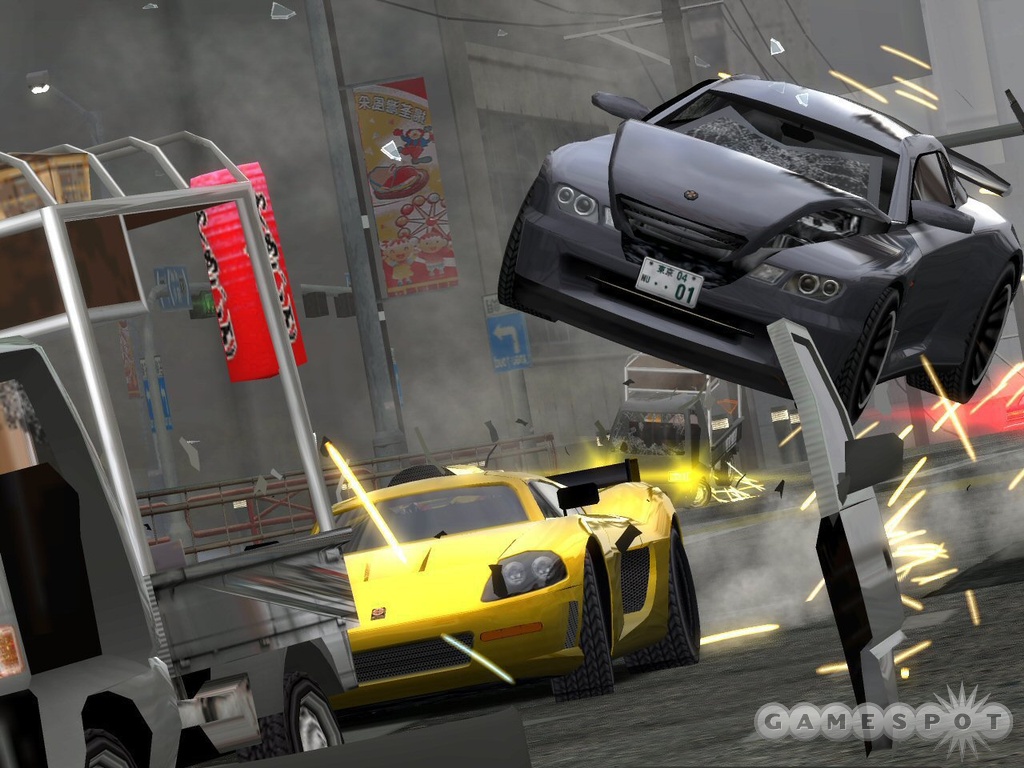Burnout Revenge Updated Hands-On
We meet with Criterion to take the latest Xbox build of its upcoming racer for an action-packed test-drive.
During a recent meeting with representatives of Electronic Arts and Criterion, we had an opportunity to get our hands on the latest, never-before-seen, arrived-on-a-plane-from-the-UK-10-minutes-ago version of Burnout Revenge. Currently scheduled for release in September, Burnout Revenge is the sequel to the sublime Burnout 3: Takedown. And if you haven't been following our previous coverage of the game, you might be surprised by how much Criterion is tinkering with what was obviously a winning formula. In fact, so many changes have been made to Burnout Revenge since we last saw the game at E3 (just a couple of months ago) that we were pretty taken aback ourselves.
The first part of the game we got to check out during our lengthy demonstration was the ever-popular crash mode, in which you'll be challenged to cause as much carnage as possible by wrecking your chosen car in a way that causes chaotic chain reactions right up until your time limit runs out. When we saw Burnout Revenge at E3, Criterion compared this year's crash mode courses to holes you might play during a game of golf, complete with a simplistic teeing-off mechanic that determines how fast you get off the line, fairways--aka freeways--full of hazards (like cars you don't want to crash into...yet), golf green-like areas (such as intersections that ooze carnage potential), and a hole that takes the form of a moving "target car" that's worth loads of points if you manage to wreck it. These comparisons still hold true, but Criterion has clearly been hard at work refining and improving upon the crash mode since it showed it off in Los Angeles.

The first thing we noticed, for example, is that the E3 version's simplistic teeing-off mechanic has been replaced by a much more challenging one. And Criterion makes no secret of the fact that it's been looking at Electronic Arts' recent Tiger Woods golf games for inspiration lately. With that said, the new "launch control" swingometer you'll use to get off the line in the crash mode is unlike anything that's been seen in a Tiger Woods game this side of the 2000 version. However, it's definitely reminiscent of the shot systems in many older golf games. Basically, there's an upswing that's used to determine the speed you peel off the line at, and there's a downswing that determines your accuracy off the line. If you manage to stop your swings in the two green areas of the swingometer, you'll start your quest for the perfect crash at high speed, while traveling in a straight line. Miss the green zones and you'll take off at a sedate pace, veering off to the left or right slightly. Worse still, there are red areas that will bring your crash attempt to an abrupt end before you even get off the line. Hitting the red zone on your upswing will cause you to blow your engine, and hitting it on the downswing will cause you to stall your car. Either way, it's going to be embarrassing in a party play situation.
One of the other new features of this year's crash mode that's totally in keeping with the golf theme is that once you get your car airborne, which will be happening a lot, it'll be affected by crosswinds that are strong enough to mess up even your best-laid plans for destruction. In the E3 version of Burnout Revenge, we were able to apply "aftertouch" to our car in this situation, effectively steering it left or right in midair. In the latest version of the game, we were also able to point the hood of our car up or down in an attempt to control the length of our jump, which proved extremely useful when attempting to land directly on top of target cars and such. Criterion has also introduced a screen-blurring effect that kicks in whenever you stray from the ideal route through the air, which is inevitable if the course you're crashing on has strong crosswinds to contend with. Your choice of car (like your choice of golf club) will also play a large part in how you approach crash courses, incidentally, since lighter cars are likely to get more air, while heavier vehicles, even if they're traveling faster when they hit a ramp, will fly at a lower trajectory.

The importance of vehicle choice was highlighted in a crash course entitled "Doh Nut Disturb," which we got to check out. To reach the busy street with the most potential for carnage, we had to fly our car through the middle of a giant donut sign on top of a store. Another challenging crash course we played required us to shunt another car into oncoming traffic while maintaining enough speed to hit a ramp and clear a gigantic chasm so we could bring the target car (and a number of high-points-scoring parked buses) into play. The most memorable crash course we saw, though, was undoubtedly one that required us to shunt multiple cars into multiple intersections, using ramps to clear the collisions we'd caused so we were able to do the same thing over again.
The Crowd Goes Wild
Toward the end of our crash attempts, of course, we were able to use "crashbreakers" to blow up our car in spectacular fashion and, with a little help from the aftertouch controls, attempt to involve more vehicles in the ongoing mayhem. The crashbreaker system in Burnout Revenge, like every other aspect of the game, has been refined and improved upon somewhat since we last saw the game, and we're pleased to report that we had a lot of fun with it. Crashbreakers will become available to you when a predetermined number of vehicles have been damaged as a result of your driving, and when they do, you'll have a few seconds to repeatedly mash a button in an attempt to make your explosion more devastating. Depending on how well you do that, you'll trigger a blue, yellow, red, or white explosion. And, yes, it'll be possible to use multiple crashbreakers on a single crash attempt if you manage to get enough vehicles involved. You'll be told how many vehicles you've managed to wreck at the end of each attempt, as well as how many vehicles it's theoretically possible to wreck. Good performances will be accompanied by applause from an unseen (and presumably terrified) crowd of onlookers.

When our time with Burnout Revenge's crash mode came to an end, we were invited to take a look at some of the game's other modes of play, including elimination races, and the all-new traffic attack mode. The elimination events work in a similar way to those in other racing games, where the car in last place is eliminated at the end of each lap until only one remains. Burnout Revenge takes things up a notch, though, by eliminating the last-place car every 30 seconds, which makes the whole experience quite frantic, particularly if you wreck. Wrecking your car unintentionally will be just as easy in Burnout Revenge as it was in Burnout 3: Takedown, because, although traffic moving in the same direction as you can now be shunted out of the way (for the most part), there are "hard stops" (such as alcoves in walls) that will bring your car to a sudden and very damaging halt if you stray (or are pushed) into them.
The other most obvious new feature of the tracks this year is that there are loads of great shortcuts for you to take advantage of. We noticed plenty of these during our time with Burnout Revenge at E3, but, concerned that testers were missing out on a lot of them, Criterion has now decided to highlight all of them with blue lights. We were a little skeptical about this new addition to the game when we were told about it, but having spent plenty of time playing the latest version, we can report that knowing where the shortcuts are is only half the battle. Besides the fact that you'll often be traveling at speeds in excess of 200mph, which (with all the great screen-blurring effects going on) makes even the blue lights quite difficult to make out at times, the other danger is that after you've spotted a shortcut, in the split second it takes for you to become indecisive about which route to take, you'll find yourself headed straight for a brick wall. Your CPU opponents won't make a habit of using shortcuts in the early stages of your Burnout Revenge career, but we're told that they'll become very skilled at doing so as you approach the latter stages of the game.
By the time you reach the latter stages of the game, you'll have competed in races all over the world, taking in beautifully realized caricatures of a number of cities and other locations. We got to see a number of these during our time with Burnout Revenge on this occasion, including Angel Valley (Los Angeles), Sunshine Keys (Florida), White Mountain (Switzerland), and Criterion's takes on Rome and Hong Kong. The locations are much more varied than those that have appeared in any of the previous Burnout games, not only in visual terms but also in the ways that they play. Angel Valley, for example, features a lot of narrow backstreets for you to negotiate and walls for you to slam your opponents into. White Mountain, on the other hand, boasts wide, winding roads down mountains and plenty of opportunities for you to force other racers off cliffs and such.

We didn't actually check out any "normal" races during our time with Burnout Revenge on this occasion, but the Criterion representatives we met with did take a moment to point out that they've changed a little since we saw the game at E3. In that version of the game, we were able to trigger a crashbreaker every time we wrecked during a race. But in the finished game, you'll only be able to do that in special crashbreaker races that appear in the latter stages of the game.
We've said it before, and we'll say it again: Burnout Revenge looks certain to improve upon its predecessor in just about every way imaginable. You can bet that we'll be bringing you more information on the game just as soon as we get our hands on a more-complete version of the game.
Got a news tip or want to contact us directly? Email news@gamespot.com
Join the conversation